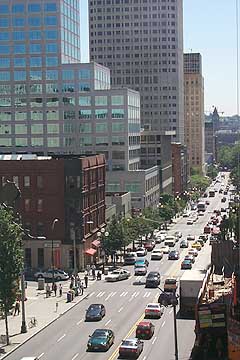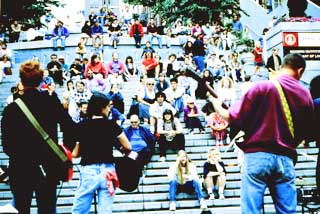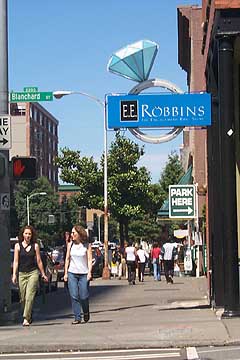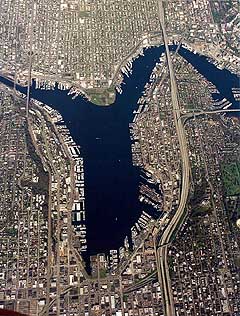
Urban Development
DJC.com
Next >
Back <
Creating a vibrant, seamless downtown requires foresight
For Seattle to secure its position as a leading-edge city, it will be imperative that we refocus our energies on connecting the whole, not just developing the parts.
By STEPHEN FINA
Harbor Properties
In the past five years, the historical boundaries of “downtown” have been redrawn. Neighborhoods once considered on the fringe or outside of Seattle’s downtown core are now firmly entrenched in it. The question no longer is whether or not these areas are a part of downtown, but instead how we can connect and integrate them. Ultimately, for Seattle to secure its position as a leading-edge city, it will be imperative that we refocus our energies on connecting the whole, not just developing the parts.

|

|
In the 1980s Seattle experienced a period of unprecedented growth and development, with the number of high-rise buildings downtown nearly doubling. The '90s marked a different kind of growth, a concerted effort focused on reestablishing downtown as a vibrant retail and residential area.
National chains, local stores and restaurants came into both the newly trendy retail core and more boutique areas like Belltown, Pioneer Square and First Avenue. Mixed-use projects such as Harbor Steps, and residential projects like Belltown Court and the Concorde brought renewed interest in urban living.
What nobody could have reasonably predicted less than a decade ago was that the historical downtown core would grow substantially – it now includes or transitions to the waterfront, the International District, Sodo, South Lake Union, Lower Queen Anne, the Denny Triangle and, arguably, Westlake Avenue North to Fremont. In addition, recently developed and proposed projects on Capitol Hill and First Hill have bridged Interstate 5, bringing in even more area. It could be just a matter of time before Broadway replaces I-5 as the eastern edge of downtown.
While the question of when and where growth will stop is fascinating to contemplate, how to maintain the long-term fabric of the city is more relevant.
Seattle’s growth has generally been centered within neighborhoods, each evolving independently of the core and often connecting at unplanned “transition points.” As local development continues to focus on in-filling these transition points, urban developers need to decide how their respective projects relate and connect to the surrounding, often unique, urban neighborhoods.
For many years, Seattle’s waterfront was split from downtown by the Alaskan Way viaduct. This separation resulted in an underused and unappreciated waterfront as well as a less-than-robust transition zone along Western Avenue. Since 1994, three major new pedestrian connectors, Harbor Steps, the Lenora Street overpass and the Bell Street overpass, have brought new life to the waterfront. The impact of these connectors can be seen not only along the waterfront (cruise ships, Go2Net, Maritime Museum, and many new restaurants), but also along Western Avenue from Pioneer Square to Denny Way.
This mile-long stretch has emerged over the past two years as one of the most popular residential streets in the city. In this case, the success of two neighborhoods resulted from both the new connectors as well as many developers’ sensitivity to integrating projects with those connectors. Ultimately, the perceived distance and separation of the areas has been eliminated through the creation of these connectors.
Downtown is full of areas that have successfully handled this distance/perception issue. Most significant is First Avenue, which contains nearly continuous retail from Pioneer Square to the Seattle Center and connects four unique neighborhoods: Pioneer Square, Harbor Steps, Pike Place Market and Belltown. This animated pedestrian experience, a function of interesting retail and restaurants, plus street art, lighting, landscaping, awnings, widened sidewalks and increasing outdoor café dining, make First Avenue the Seattle equivalent of Chicago’s Miracle Mile. It is a dynamic experience that stays active for more than 20 hours a day.

|
A different type of transition is occurring on the eastern edges of the retail core, as the area grows eastward towards I-5 and the Metropolitan Park tract. The Denny Triangle stands to become one of the most important areas of growth over the next decade and will play a major role in connecting the downtown core to outlying neighborhoods including Capitol Hill, First Hill and Cascade/South Lake Union.
The Denny Triangle, not long ago a sea of surface parking lots and run-down buildings, is emerging as a significant growth area. It surprises many that REI, at the eastern end of the Triangle, is closer to Nordstrom than Nordstrom is to the Courthouse; yet very few people even consider REI a part of the downtown core.
New projects by Clise, Continental-Bentall and The Benaroya Company, along with the Convention Center expansion, are filling in what once was a 10-block wasteland and changing the perception of downtown’s borders. The proposed redevelopment of the Quinton Instruments building, REI/Metropolitan Park and the Convention Center create anchors for this new neighborhood.
As more projects fill in the area, developers must focus on the buildings as well as how they interface with the pedestrians. They are connecting three unique neighborhoods: downtown, Capitol Hill and Cascade/South Lake Union. Complicating that is the area’s role as a major transportation connection point into and out of downtown. It is imperative that new developments help to ease the transportation challenges and create an animated and safe pedestrian experience.

|
Making this transition area a success will require a concerted effort by public and private entities alike. The end result however can be a pedestrian-oriented downtown that seamlessly connects the northern and eastern neighborhoods to the retail core, First Avenue and the waterfront.
With growth along Elliott Avenue North, 15th Avenue, the ship canal, Fremont and Westlake Avenue North, it is conceivable that downtown could grow to include the an expanded core, as well as a north ring surrounding Queen Anne, that integrates seamlessly with the continually improving Seattle Center.
Developers and planners must continue to embrace this notion of an enlarged downtown, focusing on traffic and transportation and how pedestrians interact and integrate with the city. Recent projections indicate more than 3,000 new apartments or condominiums will be added in Seattle’s downtown alone in the next three to five years. We must not be lulled into complacency by our past success. By balancing pedestrian needs with automobile and mass transit needs we can both enhance the resident, worker and visitor experience and take important steps toward solving long-term transportation and congestion issues.
Stephen Fina is the marketing director for Harbor Properties and Harbor Resorts and has been involved in the research, design and marketing of Harbor Steps as well as other Harbor projects in Seattle.
Top | Back | Urban Development | DJC.com Copyright ©1995-2000 Seattle Daily Journal and djc.com.
Comments? Questions? Contact us.